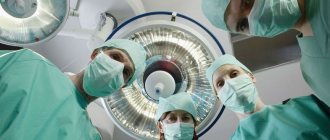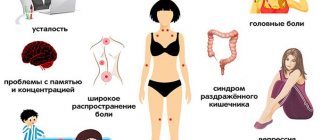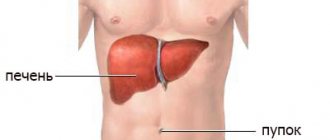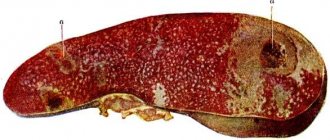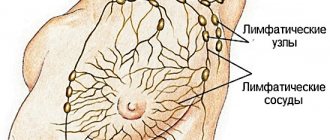For women, everything that is somehow connected with the sexual and reproductive system is a subject of special attention. Usually, if you have severe pain in the lower abdomen, emergency doctors advise you to see a surgeon or gynecologist, and if the pain is acute, hospitalization in surgery cannot be avoided. If tests and ultrasound examination do not confirm the need for surgical intervention, the woman must see a gynecologist. The most common cause of pain in the abdominal area in women is ovarian disease, and this may be one of the symptoms of chronic inflammation of another organ.
Pain in the ovaries associated with the menstrual cycle
Menstruation is the most common cause of discomfort
lower abdomen in women of reproductive age (15-44 years). In the literature you can find the concepts of “algomenorrhea” or “dysmenorrhea”, but the essence of the concepts is the same - painful menstruation. In mild form, ovulatory syndrome periodically appears in 60-70% of women. Pain that causes cramps and fainting is experienced by 10-15% of women.
There may be several reasons why discomfort occurs during menstruation:
- hormonal disorders in the body;
- neurological disorders;
- congenital structural features of the reproductive organs;
- dysplasia (impaired functioning) of ovarian tissues, due to congenital characteristics, previous infectious diseases of the pelvic organs.
By conditionally dividing the menstrual cycle into several phases, you can understand why the ovaries hurt and the lower abdomen ache during menstruation.
During your period
The first phase of the cycle is follicular. Its countdown begins on the 1st day of the onset of menstruation and continues until the onset of ovulation. The duration of the phase is on average 2 weeks.
During menstruation, the ovaries do not hurt.
The discomfort that occurs in the lower abdomen, aching pain radiating to the lower back, anus is the result of the rejection of “old” cells of the uterine mucosa. They come out in the form of menstrual bleeding with systematic muscle contractions. There is nothing unusual in this process; mild spasms are normal. But there are other causes of malaise.
With primary algodismenorrhea, the symptom begins to bother you from the first days of menstruation until adulthood. The reason is the structural features of the uterus.
Secondary dysmenorrhea appears at any age after gynecological diseases, due to organ dysfunction, surgical interventions, or the installation of an intrauterine device.
During this period, it is important to maintain moderate physical activity, drink more fluids, relax your muscles with a warm shower, and drink painkillers and sedatives.
After menstruation before ovulation
After menstruation, the process of egg maturation begins.
The follicle increases in size and reaches 15-20 mm before rupture. Normally, only one is dominant, from which the egg is subsequently released. Along with it, about 10 more follicles grow, which significantly increases the size of the organ. During the process of maturation, the ovary may hurt on the right or left, but after ovulation the discomfort goes away.
During ovulation
Ovulation is the process of releasing an egg. It determines the ability of a woman of reproductive age to conceive. With a cycle duration of 28 days, ovulation occurs on day 14, but if hormonal levels are unstable, the date may shift by several days.
When a mature follicle bursts, a woman experiences sharp pain in the ovary. This happens for several reasons:
- entry of blood and follicular fluid into the abdominal cavity and irritation of pain receptors;
- drop in estrogen and progesterone levels;
- contraction of the muscles of the fallopian tubes through which the egg passes.
Tingling in the ovaries may last only a few seconds, or may last 1-2 days.
Discomfort occurs on the side where the follicle burst. An additional sign of ovulation is slight spotting.
In rare cases, organ rupture occurs during ovulation. This is facilitated by previously carried out stimulation of follicle growth.
In addition to unbearable pain, weakness, nausea or vomiting, fever, tachycardia are observed, and the development of peritonitis is possible. The only correct measure is to urgently call an ambulance.
Treatment
On your own, at home, the appearance of early painful sensations in the ovarian area can only be dealt with if they appear during ovulation.
To do this, a woman is recommended:
- During this period, avoid excessive physical activity.
- It is allowed to take antispasmodic and painkillers.
- If possible, monitor your psycho-emotional state and prevent the occurrence of stressful and conflict situations.
- Monitor your diet, eat more vegetables and fruits, and avoid eating unhealthy foods (snacks on the go).
- If possible, give up bad habits.
Drugs
If the cause of pain is the presence of infectious and inflammatory diseases, you need to contact a gynecologist who will prescribe the correct therapy.
The use of antibacterial drugs is suitable for this.
Antibiotics of different pharmacological groups can be prescribed:
- Tetracycline group. Used: Doxycycline.
- Unidox.
- Vibramycin.
- Tetracycline hydrochloride.
Doxycycline
Tetracycline Hydrochloride
Unidox
Vibramycin
- Sumamed.
Azithromycin
Erythromycin
Roxithromycin
Sumamed
- Tsiprolet.
Ampicillin
Ampioks
Tsiprolet
Ofloxacin
Solutab
- Cycloferon.
Cycloferon
Derinat
Interferon
Laferon
After completing antibacterial therapy, the use of probiotics is prescribed. This helps to normalize the intestinal and vaginal microflora.
Usually prescribed:
- Bifiform.
- Linux.
- Lactobacterin.
Bifiform
Lactobacterin
Linex
Such treatment is prescribed only in cases where there are no urgent indications for surgery.
When choosing a treatment method, it is necessary to take into account that pain in the ovaries are symptoms of the underlying disease. That is, the disease must be treated first, and the negative symptoms will be eliminated as the disease is cured.
Folk recipes
As an additional method of treatment, you can use decoctions and infusions of medicinal herbs. Before doing this, you need to consult a doctor and coordinate the use of herbs with medications.
For this use:
- Decoctions and infusions of yarrow herb. A spoonful of this herb is poured with boiling water in a volume of 250 ml, then poured into a thermos and infused for 15 minutes. The decoction can be used several sips throughout the day.
- You can use the herbs of centaury, sweet clover and coltsfoot flowers to prepare a decoction. They are used by dissolving 20 grams of each herb in boiling water (250 ml). The prepared solution is infused in a thermos for an hour. Strain and drink 50 ml throughout the day.
- Medicinal tea can be made from lemon balm. To do this, you need to pour four tablespoons of the herb into a glass of hot water. After an hour, drink as tea 3 times a day.
- A good effect is observed when drinking pumpkin juice . It can be made using a blender and drunk early in the morning before meals.
- Juniper berries can be used by first selecting 15 berries and pouring boiling water over them. It is recommended to use this decoction throughout the day, one spoon every 6 hours.
During and after intercourse
Normally, sexual intercourse does not cause discomfort. Pain during intercourse can be caused by:
- development of inflammation of the pelvic organs;
- the occurrence of cystic formations;
- too intense sexual intercourse;
- organ rupture;
- changes in organ size caused by drug stimulation;
- the appearance of cysts, malignant and benign tumors on the glands;
- hormonal disorders;
- strong tension of the vaginal muscles.
This problem should not go unnoticed. Discomfort during sex is a threat not only to health, but also to relationships with your partner.
Diagnostics
To confirm the diagnosis, the doctor conducts a comprehensive examination, interviews the patient about the nature and duration of pain, and associated symptoms. General scheme of examination of the patient:
- examination on a gynecological chair: a smear to identify infectious pathogens, determine the state of the vaginal microflora, diagnose acute or chronic inflammation, HPV, herpes, chlamydia;
- determination of pH indicators of vaginal acidity;
- hormonal study: estradiol, testosterone, follicle-stimulating hormone;
- Ultrasound of the pelvic organs: using a transvaginal sensor, the diagnostician examines the uterus and ovaries. The day of the cycle for the study is selected depending on the general clinical picture and the woman’s age;
- MRI of the pelvic organs is used infrequently, only when it is necessary to obtain more detailed and accurate information about the woman’s reproductive system.
Additionally, it is recommended to take a general and biochemical blood test, urine test, coprogram, and stool test for dysbacteriosis.
After surgery
Surgical treatment is a necessary and preferable treatment measure for polycystic disease, the occurrence of neoplasms, and rupture of the ovarian organ.
Laparoscopy
Most operations are performed through small incisions in the lower abdomen, preserving the organs. Postoperative pain persists for several days. If the rehabilitation period is delayed, the reasons may be as follows:
- development of adhesive and inflammatory processes;
- non-compliance with the terms of sexual rest;
- lifting weights;
- internal bleeding due to suture dehiscence.
A deviation from the norm is considered to be pain lasting more than 2-3 days, accompanied by tension of the uterus and ovaries, nausea, and vomiting.
Puncturing
Another type of mechanical impact on organs is puncturing. It is carried out when it is necessary to take biomaterial for IVF, collect cells for histological examination, or eliminate a cyst.
After a puncture, the following is considered normal:
- moderate pain;
- mild cramps in the lower abdomen;
- scanty discharge;
- increase in body temperature to subfebrile level.
During pregnancy
Intrauterine development of the fetus is not the cause of the unpleasant symptom, but in the early stages a woman may feel some discomfort in the lower abdomen.
After the implantation of the egg into the uterine cavity, which may be accompanied by slight bleeding and soreness (implantation pain), the corpus luteum continues to perform its functions for some time. By producing progesterone and oxytocin, it supports pregnancy and relaxes the uterus. Due to the growth of the gland, its capsule is stretched, and the woman begins to feel pain. If the right or left ovary is slightly pulled, do not worry. The larger the corpus luteum, the more successful the first trimester of pregnancy will be. Later, the placenta takes over the function of producing hormones.
Summing up
All women periodically feel painful shootings in the back, especially in the lumbar region. This may be due to prolonged sitting, work, or due to a gynecological disease. It is very important to be able to recognize the symptoms and visit a gynecologist, and then undergo an examination.
Important ! Gynecological diseases can provoke a lot of unpleasant symptoms, and sometimes indicate a serious illness that must be eliminated surgically. The most important thing is to be aware of the problem and solve it in a timely manner. Do not avoid visiting a doctor, because preventing a disease is much easier than curing it.
In case of termination of pregnancy
Signs indicating the development of an ectopic pregnancy:
- sharp, intensifying pain radiating to the anus;
- irregular spotting; drop in hCG hormone levels;
- dizziness; decrease in blood pressure.
Any discharge during pregnancy should cause concern. Accompanied by intense pain, they can mean spontaneous termination of pregnancy. Timely consultation with a doctor increases the chance of saving the child.
Another pathology during pregnancy is fetal freezing. In this case, the woman experiences mild pain or does not feel it at all, but notices heavy discharge from the uterine cavity.
Possible complications
The lack of high-quality, timely therapy is fraught with progression of the disease and the development of serious complications. The likelihood of spreading the inflammatory process, bleeding, developing anemia, and transforming the disease into a chronic form increases. In the future, this is fraught with the threat of premature termination of pregnancy, infertility, and premature menopause. To prevent possible complications, it is necessary to be regularly examined by a gynecologist, promptly treat inflammatory, viral, bacterial diseases, and direct efforts to identify and eliminate parasites.
Pain radiating to the leg
The female reproductive organs react acutely to hypothermia, as they are most susceptible to infections, so pain is often caused by the development of inflammatory processes.
If the left ovary hurts, the cause may be unilateral oophoritis. It is possible that the pathological process will develop only on the right side or that all reproductive organs may be involved in the process. In this case, adnexitis is diagnosed - inflammation of the appendages, salpingitis - inflammation of the fallopian tubes.
The following symptoms are characteristic of oophoritis:
- the ovary pulsates, the pain radiates to the leg, lower back;
- difficulties urinating are noted: pain, incomplete emptying of the bladder;
- the intensity of discharge from the genitals increases;
- body temperature rises;
- before the onset of menstruation, scanty bleeding is observed for 3-5 days;
- sexual intercourse causes discomfort.
With an advanced form of the inflammatory process in the ovaries
a woman regularly observes leucorrhoea (scanty whitish discharge), experiences mild aching pain that intensifies before the start of the monthly cycle. Oophoritis can cause infertility, and the accompanying salpingitis leads to the occurrence of ectopic pregnancy due to the development of adhesions.
Syndromes
Increased load on the spine and in particular on the sacrum and lumbar region. Typically, such pain is nagging and occurs if a woman has performed physical activity or exercises that are unusual for her body. The pain may be associated with muscle strain, which with timely and proper treatment can be eliminated in 3-4 days. But, in any case, you need to consult a specialist, because pain may indicate displacement of the spinal discs, which is dangerous to health.
Osteochondrosis. Pain often occurs in women due to the destruction of cartilage tissue, which can later lead to intervertebral hernia. With this disease, the pain is very sharp, spreads throughout the body and radiates strongly to the limbs.
Pain in the ovaries with a cyst
A cyst is a cavity formation filled with fluid. Most ovarian cysts are false (functional). They are formed when the follicle does not rupture, but remains in the body of the organ. There is also a corpus luteum cyst; hemorrhagic, which occurs when blood vessels rupture inside the corpus luteum or follicle.
Small cysts resolve with the onset of a new menstrual cycle without causing discomfort. An increase in tumor of more than 2 cm causes:
- heaviness in the stomach;
- urinary disturbance.
The pain with an ovarian cyst reaching a size of 5 cm is more intense and has a stabbing and cutting nature. The pressure of the formation on neighboring organs causes constant pulling sensations in the lower abdomen. With further growth, the ovarian cyst may rupture. Provoking factors: sports, sexual intercourse, injuries.
When a rupture occurs:
- stool disorders:
- tension in the anterior abdominal wall;
- sharp unilateral pain radiating to the sacrum and thigh;
- bleeding.
Large cysts, reaching 7 cm and having an elongated stalk, can twist.
Symptoms of torsion:
- discomfort that forces you to take the “embryo” position and spreads to the back, groin, legs;
- the appearance of perspiration;
- increased body temperature;
- bloody issues;
- nausea, vomiting;
- pallor, decreased blood pressure.
Sharp but short-term pain is a rupture of a follicular cyst that does not require hospitalization.
It is necessary to distinguish between a cyst and polycystic ovary syndrome. The latter is the result of endocrine disorders. Polycystic disease is the cause of constant low-intensity pain due to enlarged ovaries covered with small cystic formations. The main problem of women with polycystic disease is infertility caused by hormonal imbalance. The disease can be corrected with proper nutrition and hormonal therapy.
Pain in the ovaries caused by pathologies of other organs and systems
Pain that occurs in the lower abdomen is often associated with pathologies of other organs. By giving pain to the lower back and leg, it makes it difficult to understand what exactly triggered it. The causes of discomfort may be:
- aneurysm of the femoral artery, manifested by throbbing pain and swelling in the groin area;
- inguinal or femoral hernia;
- kidney disease (urolithiasis, pyelonephritis);
- inflammation of the appendix;
- development of pathological processes in the rectum or bladder;
- the occurrence of adhesions as a result of inflammation, previous operations.
Only high-quality diagnostics will help resolve the issue of further treatment.
When to see a doctor
Of course, stabbing sensations in the appendage area are rarely a sign of pathology, however, if they bother a woman and are accompanied by other symptoms, she should consult a doctor. Pregnant women should be especially attentive to their condition and well-being. As soon as pain appears, it is recommended to obtain medical advice. To determine the cause of stabbing pain in the appendages, the doctor will prescribe an ultrasound and tests for infections of the reproductive system. If tingling turns out to be normal, no treatment will be required, however, if infections, inflammatory processes or neoplasms are detected, the woman must undergo drug therapy.
According to statistics, patients aged 18 to 25 most often complain of stabbing pain in the appendages, who, as a result, do not have any physical prerequisites for their formation. Most often, the sensations are caused by psychological factors, stress or depression. Consultation with a psychotherapist, breathing exercises and taking sedatives will help eliminate such conditions.
We recommend you learn: What is an ovarian epididymis?
Acute pain in the ovaries
The ovaries often hurt greatly if there is a threat of their rupture, in advanced forms of the disease.
Hyperstimulation
Ovarian hyperstimulation syndrome occurs
in the treatment of infertility due to lack of ovulation, the use of IVF. The process consists of prescribing hormonal drugs in the form of tablets, injections, sprays that promote follicle growth. Hyperstimulation is the result of incorrect dose selection or excessive individual sensitivity of the body to the drug.
Conventionally, hyperstimulation is divided into 3 stages:
- Easy. At the same time, the volume of the abdomen increases, swelling and slight nagging pain in the groin are observed.
- Average. Nausea, diarrhea appear, shooting in the ovary, the stomach protrudes significantly, and body weight rapidly increases.
- Heavy. The listed symptoms are accompanied by shooting, stabbing, pulling pains that are observed at the slightest change in body position. At the same time, the pressure decreases, the heart rhythm is disturbed, and shortness of breath occurs.
At stage 3, there is a high probability of ovarian rupture. The incidence of grade 3 hyperstimulation during pregnancy ranges within 10%.
Apoplexy
Rupture of the ovary, accompanied by acute severe pain, is called apoplexy. Synonyms for this concept are hematoma or ovarian infarction.
Most often it is the right ovary that hurts and radiates to the leg. This is due to the fact that the blood supply to the right-sided organ is provided by the ovarian artery coming from the aorta, while the left is supplied by the renal artery. As a result, the gland on the right is larger in size. On the left, ruptures are less common.
Women of reproductive age are at risk.
Apoplexy is an emergency condition requiring emergency medical care.
Factors that increase the likelihood of apoplexy are:
- inflammatory processes occurring in the pelvic organs;
- sclerotic changes in the tissues of the glands, taking drugs that affect blood clotting.
Apoplexy can be triggered by trauma in the abdominal area, the process of irrigating the uterus with a syringe, examination by a gynecologist, or intense sexual intercourse. If the rupture occurs at rest, endogenous factors take place: abnormal location of the uterus, tumor development, adhesions and other disorders.
The main symptom of a glandular infarction is a sharp, sudden pain in the ovarian area caused by the effect of blood on pain receptors.
There are 2 forms of apoplexy:
- Painful, or pseudoappendicular. It is often mistaken for an attack of appendicitis. In addition to unbearable acute pain, nausea begins, blood pressure drops sharply, which is expressed in pale skin and loss of strength.
- Hemorrhagic or anemic. The main signs are lightheadedness, pallor and nausea as a result of blood loss (up to 150 ml in mild cases and more than 500 ml in severe cases).
Prevention
For prevention, it is necessary to undergo regular check-ups with a gynecologist: at least once every 6 months. The earlier the pathology is identified and efforts are made to eliminate it, the more favorable the prognosis. Doctors also suggest following these preventive recommendations:
- refrain from casual sexual intercourse, when changing partners, ask for a certificate of absence of sexually transmitted infections, hepatitis, use barrier methods of contraception
- correctly observe the rules of personal hygiene: wash yourself twice a day with plain water, without soap or aggressive detergents that disrupt the vaginal microflora
- use underwear made from natural, undyed fabrics, do not wear too tight trousers and jeans, which interfere with blood circulation in the pelvic organs
- If possible, reduce the use of sanitary pads, especially daily ones: chemicals, dyes, fragrances easily enter the body through the skin and mucous membranes, negatively affecting the functioning of the reproductive system
- enrich the diet with clean, living food: fresh, seasonal vegetables, fruits, berries, nuts, seeds, fermented foods to support the microflora of the vagina and intestines
- refrain from bad habits: smoking, drinking alcohol, overeating
- Reduce toxic load: use natural, herbal antiviral and antiparasitic drugs under medical supervision and advice
- restore detox: use courses of choleretic drugs, glutathione precursors, alpha-lipoic acid to remove heavy metals
- normalize intestinal function: as necessary, use enzyme medications, betaine, probiotics, metabiotics, inulin, apple pectin, psyllium husk
- maintain a drinking regime: the daily fluid intake can be calculated using the formula 30 ml multiplied by body weight
All organ systems and biochemical processes in the body are interconnected, therefore the best result without the risk of repeated relapses of the disease can only be achieved with complex, long-term exposure. All changes begin in lifestyle: nutrition, sleep, stress. At the first symptoms of the disease, it is important to refrain from self-medication and seek advice from an experienced, qualified specialist.
